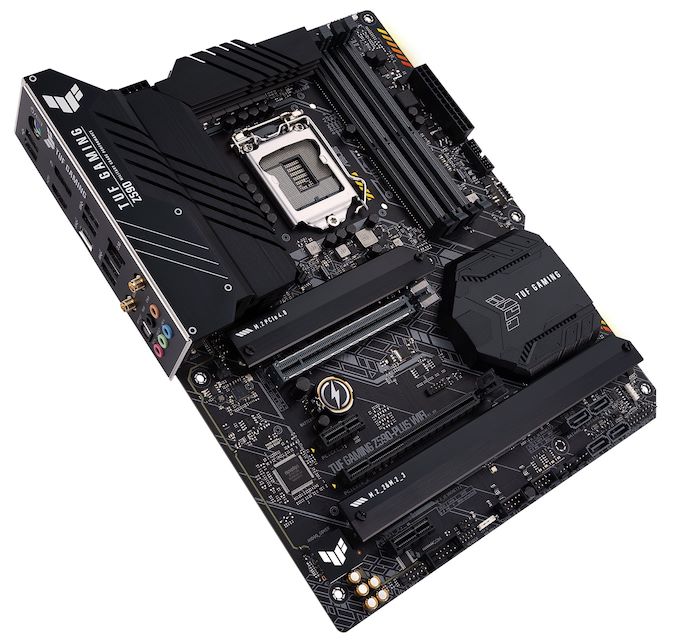ASUS TUF Gaming Z590-Plus WIFI Motherboard Review: Is $260 Mid-Range or High-End?
by Gavin Bonshor on August 10, 2021 10:00 AM ESTConclusion
What you get in terms of motherboard features and specifications for the money has changed wildly over the last 5-10 years. Whereas a $250-$300 motherboard would yield flagship status 'back in the day,' now you're looking at something in the mid-range. The ASUS TUF Gaming Z590-Plus WIFI represents a more 'mid-level' gaming series, and it has all the bell and whistles expected of a board in its price range.
Some of the most notable features on the ASUS TUF Gaming Z590-Plus WIFI includes triple M.2 for users looking to use fast storage capability, with one of these slots offering support for the fastest PCIe 4.0 x4 NVMe based drives; the other two are limited to PCIe 3.0 x4/SATA support from the chipset. ASUS also includes six SATA ports for conventional devices and storage, all with support for RAID 0, 1, 5, and 10 arrays offered by the Z590 chipset. For memory, ASUS allows users to install up to 128 GB of DDR4-5133 across four slots, which is around the standard for a model of this pedigree.
There's plenty of connectivity, which includes one USB 3.2 G2x2 Type-C on the rear panel, which is a benefit of going with Z590. Other connections include dual USB 3.2 G2 Type-A, two USB 3.2 G1 Type-A, and two USB 2.0 ports on the rear panel, with plenty of expansion support via front panel headers. ASUS also opts to use one of the better HD audio codecs for its onboard audio solution, with a Realtek ALC S1200A HD powering five 3.5 mm audio jacks, a S/PDIF optical output, and also drives a front panel audio header for users with a chassis that supports this. Networking support is also pretty standard, with an Intel AX200 Wi-Fi 6 CNVi and I225-V 2.5 GbE pairing providing improved connectivity over previous generations of Intel's desktop platforms.
Focusing on the bread and butter of any analysis, which is the performance, the TUF Gaming Z590-Plus WIFI performed credibly in our testing. Power efficiency is a strong point with good results in our power consumption testing and a respectable showing in our non-UEFI POST time testing. However, we found that this board isn't DPC latency optimized out of the box, and if that's a buying requirement, we recommend other Z590 models for this. In our computational and gaming tests, the ASUS held its own and showed its performance with credit compared to other Z590 models on test.
When it came to overclocking, the TUF Gaming Z590-Plus WIFI didn't perform in line with our other Z590 boards. Despite good levels of VDroop when we manually overclocked with our Core i9-11900K, we weren't able to achieve 5.2 GHz all-core stability in our testing. We know our testbed chip can do 5.3 GHz all-core on some of the better models, and this was a little disappointing that we could only achieve 5.1 GHz. That being said, regarding VRM thermal performance, the ASUS did perform very well against other models we've tested so far, especially for the price; we got similar VRM temperatures on the ASRock Z590 Taichi, and that has active cooling, not passive like the ASUS. This is a good win for ASUS as it shows efficiency in heat dissipation and an effective VRM design.
Final Thoughts: The $200-300 Z590 Market is Highly Competitive
When selecting a Z590 motherboard in the sub $300 bracket, there's perhaps more choice than other price points. The ASUS TUF Gaming Z590-Plus WIFI is available for $259 and has a solid feature set, and holds its own in our testing. Just above this model in the marketplace is the MSI MAG Z590 Tomahawk WIFI ($265), which for $6 includes Intel's latest Wi-Fi 6E CNVi. The rest of the specifications are similar, and if wireless networking isn't a buying requirement, ASUS does have a non-Wi-Fi variant of the TUF Gaming Z590-Plus for the lower price of $230. We feel there is much better value to be had for this version, as users could add their own Wi-Fi 6E CNVi module for around the cost of the model we've reviewed today.
Overall the ASUS TUF Gaming Z590-Plus WIFI offers a good package, but we feel the non-Wi-Fi model offers much better value.











23 Comments
View All Comments
COtech - Thursday, August 12, 2021 - link
Would this board do better overclocking a 11600K ?Oxford Guy - Sunday, August 15, 2021 - link
14nm is overclocked.Aliguts - Saturday, August 14, 2021 - link
Do these Muscle and Strength Exerciseshttps://aligfits.com/muscle-and-strength/